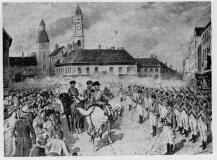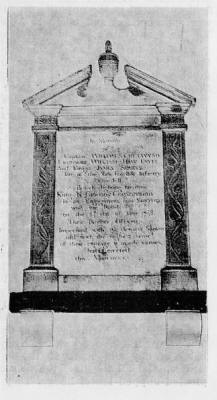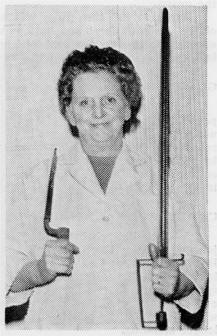 |
 |
 |
 |
|
Book Cover |
Battle of Ballynahinch
An Aerial View of the Major Sectors. |
Are you able to hold up your child Matthew |
"He planted the right ... under Dillon's left jaw." |
 |
 |
 |
 |
Henry Joy McCracken
He struck the first blow. |
A
view of Ednavady Hill taken from the Dromore Road |
This miniature of Betsy Gray, which is in the
possession of Mr. C. J. Robb, Spa. |
A
view of Windhill Hill, taken from foot of Ednavady Hillon Dromore
Road. |
 |
 |
 |
 |
The axe reputed to have been used in the execution of Monro
(Photo by late T. McNeilly, Ballynahinch). |
The Irish Volunteers being reviewed at Lisburn in 1782. Amongst the
onlookers on the left is a man with his hand to his chin. He is
Henry Monro, who became the insurgent leader at Ballynahinch. |
This photograph of the pistol believed to have been carried by Betsy
Gray at the Battle of Ballynahinch |
The memorial which was erected on Betsy Gray's grave in a vale in
the townland of Ballycreen, about two miles from Ballynahinch. |
 |
 |
 |
 |
|
Mr. James Mills, of Antrim Road, Ballynahinch, at the grave of Betsy
Gray. The letters ZABE are still legible on one of the slabs of
granite which formed part of the memorial. |
A
photograph of the opposite side of the memorial. This reads:
"Erected by James Gray, grandnephew of Elizabeth and George Gray,
1896". |
Memorial to Soldiers
This memorial in Comber Parish Church |
This headstone in Killinchy Parish Churchyard marks the grave of Dr.
James Cord, who was hanged at Downpatrick, after courtmartial, on
23rd June, 1798, for his part in the Rebellion. He was aged 31
years. |
 |
 |
 |
 |
|
UNIFORMS - A group of boys from Saintfield Intermediate School
wearing Militia uniforms of the late 1700's, which belong to Col. M.
C. Perceval-Price of Saintfield House. |
The scene at Saintfield near the Secondary School, where the
skirmish known as the Battle of Saintfield took place.
|
The epaulette from uniform worn by James Robb at the Battle of
Ballynahinch, and the jug from which he drank when wounded. |
The key of the original door to McKee's house, which is now in the
possession of Mr. Robert McKee of Carricknaveigh, Saintfield. |
 |
 |
 |
 |
Mr. C. J. Robb consulting one of his volumes of manuscripts.
|
The house at Carricknacessna, Saintfield in which the McKee family
were burned to death by the Insurgents. |
Hans Gray's pewter plates, sugar tongs and signed Oath of
Allegiance, also set of Georgian silver spoons, Georgian glass,
guinea box and pistol, which are heirlooms of Miss Betsy Gray
Macartney. |
A
recent picture of the Gray's Cottage at Garvaghy.
|
 |
 |
 |
 |
|
This is a view of Betsy's Cottage as it is to-day. Corrugated iron
covers the original thatch, and the building is used as an out
office. The original rafters in the roof of the kitchen and the "glaik"
or "glaiks" (a wooden contrivance for working the plunger of the
churn) are still to be seen. |
Betsy Gray's cottage taken from an old Photograph
This picture, taken from an old postcard, shows the late Mr. George
Macartney with his dog at the door of Betsy Gray's cottage, which
stands about 300 yards off the main road, near the Six Road Ends.
|
Mr. Thomas McMaster, of Drumgavelin, with a sword which was found 20
years ago in the thatch of a house belonging to his father, the late
Mr. Hamilton McMaster, at Glassdrummond, Ballynahinch. |
Among the old weapons found in York Island, Saintfield, are a sword
and a bayonet, which were discovered about 10 years ago by Mr. Billy
Grant. Among the old weapons found in York Island, Saintfield, are a
sword and a bayonet, which were discovered about 10 years ago by Mr.
Billy Grant. |
 |
 |
|
|
|
Mr. Wallace Mitchell, Lake View. Corbet, Banbridge, with a pike
which is reputed to have been used in the Battle of Ballynahinch.
|
A
standard British Army bayonet of the 1798 period which was found at
Creevy's Rocks. It was probably taken by one of the insurgents at
the Battle of Saintfield and left behind at Creevy- Rocks on the way
to the Battle of Ballynahinch. |
|
|